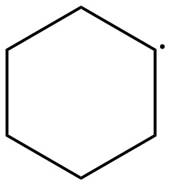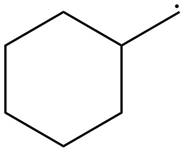
Concept explainers
(a)
Interpretation: The given radical is to be classified as
Concept introduction: A free radical is an atom or ion with unpaired electron. They are reactive intermediates formed by the homolysis of covalent bond. Free radicals are classified as
Answer to Problem 15.1P
The given free radical is classified as
Explanation of Solution
The given species is,
![]()
Figure 1
The given free radical is attached to two carbon atoms. Thus, it is classified as
The given free radical is classified as
(b)
Interpretation: The given radical is to be classified as
Concept introduction: A free radical is an atom or ion with unpaired electron. They are reactive intermediates formed by the homolysis of covalent bond. Free radicals are classified as
Answer to Problem 15.1P
The given free radical is classified as
Explanation of Solution
The given species is,

Figure 2
The given free radical is attached to three carbon atoms. Thus, it is classified as
The given free radical is classified as
(c)
Interpretation: The given radical is to be classified as
Concept introduction: A free radical is an atom or ion with unpaired electrons. They are reactive intermediates formed by the homolysis of covalent bond. Free radicals are classified as
Answer to Problem 15.1P
The given free radical is classified as
Explanation of Solution
The given species is,

Figure 3
The given free radical is attached to two carbon atoms. Thus, it is classified as
The given free radical is classified as
(d)
Interpretation: The given radical is to be classified as
Concept introduction: A free radical is an atom or ion with unpaired electrons. They are reactive intermediates formed by the homolysis of covalent bond. Free radicals are classified as
Answer to Problem 15.1P
The given free radical is classified as
Explanation of Solution
The given species is,

Figure 4
The given free radical is attached to one carbon atom. Thus, it is classified as
The given free radical is classified as
Want to see more full solutions like this?
Chapter 15 Solutions
Package: Loose Leaf for Organic Chemistry with Biological Topics with Connect Access Card
- A mixture of C7H12O2, C9H9OCl, biphenyl and acetone was put together in a gas chromatography tube. Please decide from the GC resutls which correspond to the peak for C7,C9 and biphenyl and explain the reasoning based on GC results. Eliminate unnecessary peaks from Gas Chromatography results.arrow_forwardIs the molecule chiral, meso, or achiral? CI .CH3 H₂C CIarrow_forwardPLEASE HELP ! URGENT!arrow_forward
- Identify priority of the substituents: CH3arrow_forwardHow many chiral carbons are in the molecule? OH F CI Brarrow_forwardA mixture of three compounds Phen-A, Acet-B and Rin-C was analyzed using TLC with 1:9 ethanol: hexane as the mobile phase. The TLC plate showed three spots of R, 0.1 and 0.2 and 0.3. Which of the three compounds (Phen-A; Acet-B or Rin-C) would have the highest (Blank 1), middle (Blank 2) and lowest (Blank 3) spot respectively? 0 CH: 0 CH, 0 H.C OH H.CN OH Acet-B Rin-C phen-A A A <arrow_forward
 Organic Chemistry: A Guided InquiryChemistryISBN:9780618974122Author:Andrei StraumanisPublisher:Cengage Learning
Organic Chemistry: A Guided InquiryChemistryISBN:9780618974122Author:Andrei StraumanisPublisher:Cengage Learning
